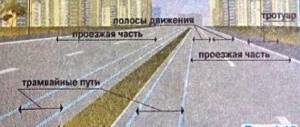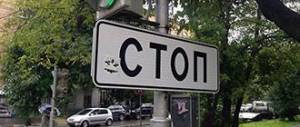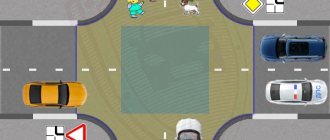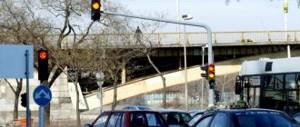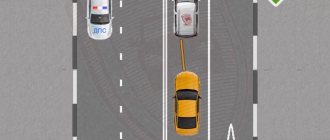Who is required to give way?
| 1. | Truck driver. |
| 2. | Driver of a car. |
The "End of lane" sign informs about the end of the lane. Consequently, the driver of a passenger car will have to change lanes to the left, and when changing lanes, he will have to give way to a truck moving in the same direction without changing lanes.
Possible fines in case of an accident while changing lanes
Penalties for an accident while changing lanes depend on the specific situation. First, you need to find out which paragraph of the Code of Administrative Offenses of the Russian Federation was violated by the person responsible for the traffic accident.
- If the culprit of the accident did not turn on the light signal during the maneuver, then its violation is stipulated by Article 12.14 of the Code of Administrative Offenses of the Russian Federation and is punishable by a fine of up to 500 rubles.
- For a long period of changing lanes and thus creating an obstacle on the road - up to 500 rubles, part 1 of Art. 12.16 Code of Administrative Offenses of the Russian Federation.
- If the maneuver is performed at an intersection and the driver did not give way to a vehicle that had priority at this intersection, Part 2, Article 12.13, up to 1000 rubles.
- The car entered the intersection and, when changing lanes, interfered with those performing lateral movement, Part 1, Article 12.13, 1000 rubles.
- If the speed limit was violated during the maneuver, the fine ranges from 500 rubles to 5 thousand. Art. 12.9.
Often, when changing lanes, drivers violate the rules of crossing markings. This is punishable by a fine under Part 1 of Article 12.16 of the Administrative Code of up to 500 rubles.
In this case, regardless of the administrative fine, the culprit (or the culprit’s insurance company) must compensate the injured party for the damage.
The fine may be increased if, after an accident, the driver did not display an emergency sign when changing lanes. In this case, up to 1 thousand rubles can be added to the existing amount under Article 12.5 of the Administrative Code.
If during an accident there are victims who suffered serious harm to health or died, liability becomes criminal.
Who should give way?
| 1. | Driver of a car. |
| 2. | Truck driver. |
Since there is a narrowing of the road ahead, as warned by the “Narrowing of the Road” sign, the truck driver will have to change lanes into the adjacent lane, and when changing lanes, he must give way to a passenger car moving in the same direction without changing the direction of movement.
From whom should we recover damages?
The insurance company of the person responsible for the incident must pay for the damage. You should first assess the damage caused to the car. This is done directly by insurance company specialists. When drawing up a European protocol, both participants in an accident must contact their insurers within 5 days. If the traffic accident was recorded by the traffic police, the period of application increases to three years.
The period of 3 years is stated in Art. 196 of the Civil Code of the Russian Federation, on the intricacies of contacting an insurance company after filling out the European protocol in Federal Law No. 40, Art. 11. Sometimes you have to recover money directly from the culprit of the accident.
The insurance company of the person at fault during a lane change accident pays the victims for the restoration and repair of the car, as well as the damage caused to health. The insurance payment limit is 400 thousand for each injured vehicle in an accident. If people were injured in an accident, then the limit for their treatment increases to 500 thousand according to 07.2014 N 223-FZ.
When the damage to an innocent driver does not exceed 100,000 rubles, it is permissible to draw up a Europrotocol using a paper form, even if there are disagreements. In case of damages from an accident from 100,000 rubles. up to 400,000 rub. It is permissible to draw up a Europrotocol only if there are no disagreements and using the special application “Accident.Europrotocol”.
The missing amount must be recovered from the personal funds of the culprit of the accident in accordance with Art. 1072 Civil Code of the Russian Federation. This happens in the following cases:
- The damage caused was greater than the limit.
- The guilty party does not have an issued MTPL policy or the company, for some reason, refused to pay the damage. Then the citizen himself reimburses the required amount in full, also under Art. 1072 of the Civil Code of the Russian Federation.
Payments can be negotiated peacefully or through legal proceedings. In any case, it is advisable to conduct an independent examination of the damaged vehicle in order to accurately know the objective amount of compensation. For a peace agreement, a pre-trial claim is sent to the perpetrator, a copy of which is kept by the victim. If the citizen refuses, then file a lawsuit. At the court hearing, it is necessary to prove the guilt of the second participant and provide documents on the amount of damage, preferably with an independent expert opinion.
The driver of a car changing lane to the right lane in this situation:
| 1. | Must not interfere with a car moving in the right lane. |
| 2. | Has an advantage because it completes the overtaking. |
The driver of a car changing lanes, including completing overtaking, must not interfere with a car moving in the same direction without changing the direction of movement.
Arbitrage practice
In court and during an investigation, to find the culprit, several parameters are always taken into account: speed and trajectory of movement, keeping a distance, the sharpness of the maneuver performed. Here are some cases from judicial practice:
- A driver who was found guilty of failing to yield while changing lanes filed a complaint and won his case. This happened because the motorist was able to present photo and video evidence that he managed to change lanes before the victim, which means he should not have given way. He had priority traffic at the time of the accident. Mutual rebuilding is considered the most difficult situation. If two cars start moving into the same lane at the same time, then priority will be given to the car that leaves the marking area first and takes the target lane. The right-hand rule in this case, according to clause 8.4, no longer applies. But many drivers refer to this rule, and therefore accidents occur. You should carefully monitor such situations and analyze the behavior of other road users.
- In one of the courts in the city of Tver, a decision was made to only partially satisfy the claim of the victim, since he himself was moving at a higher speed than permitted on this section of the road. The speed limit is always taken into account, so those who like to “slip through” and complete the maneuver faster may find themselves guilty even if they follow the rules of the maneuver.
- Often in controversial situations, the court appoints both parties as mutually guilty of an accident. In such situations, both insurance companies pay for the damage under MTPL.
If controversial situations arise, additional details are considered: how well both drivers observed the distance and speed limit. Also, be sure to check with eyewitnesses or cameras whether the warning turn signals were turned on.
In this situation, in order to continue driving in a forward direction, you are allowed to:
| 1. | Pass the truck on the right. |
| 2. | Continue driving only after the truck makes a left turn. |
| 3. | Any of the above actions is permitted. |
To continue moving, you have the right to perform any of the listed actions. It should be taken into account that when changing lanes to the right, you must give way to all vehicles moving in the same direction.
What to do in case of an accident while changing lanes?
Every driver on the road must be prepared for unforeseen situations. Even if he is recognized as injured in an accident, it is important to correctly assess the situation and take the necessary measures in the event of an accident.
Attention! If you have any questions, you can chat for free with a lawyer at the bottom of the screen or call Moscow; Saint Petersburg; Free call for all of Russia.
In the event of a traffic accident, you need to perform several mandatory actions (clause 2.5 of the traffic rules):
- Turn on the hazard warning lights and install an emergency sign according to the traffic rules (this is a triangle-shaped sign). Within the city, it must be installed 15 meters from the vehicle. Outside the populated area this distance is 30 meters. If an accident occurs around a bend while changing lanes, then the sign must be placed in front of it so that other road users can react in time.
- Drivers and cars must remain at the scene of the accident until inspectors arrive. If cars interfere with travel, then in accordance with clause 2.6.1 of the Traffic Regulations, if only property is damaged, but the vehicles greatly interfere with traffic, then they must be removed and the road cleared. But experts recommend first consulting with the traffic police inspector on duty. Sometimes it is better to receive a ticket for not removing your vehicle from the scene of an accident than to become the culprit.
- If it is necessary to clear the road, the location of objects in the emergency area should be recorded in writing in front of witnesses. It also wouldn’t hurt to photograph them or record them on a video camera so that there is evidence when identifying the guilty party.
- If there are victims, be sure to call an ambulance. If you do not have special knowledge, do not move injured people yourself and do not provide assistance to them, except in cases of real danger (for example, a car is on fire). Ambulance number 113 or 03.
- Write down contact information for all witnesses. This way, it will be easier for the inspector arriving at the scene to identify the culprit in an accident during a lane change - the more information eyewitnesses give, the better. If there are residential buildings around, and after the accident it will be difficult to identify the culprit, then within a few days you can go around and interview residents whose windows overlook the road, and you may be able to identify additional witnesses.
- Call the traffic police. Report the time and place of the incident. The police phone number is 02. This is a general number that you can also call the traffic police.
- If there are no victims in the accident, the damage is minimal, there is no disagreement about the guilt of the parties, and only 2 vehicles are involved in the accident when changing lanes, then you can issue an Eroprotocol, without calling the traffic police under Art. 11.1 Federal Law No. 40.
Those involved in an accident should calm down and use all available facts to prove their innocence or reduce the level of guilt. When changing lanes, an important factor is the priority when moving, the inclusion of turn signals, as well as the speed when performing the maneuver. If there are no witnesses, then it is worth finding out whether the accident was recorded by the external surveillance camera of neighboring stores.
Rules for changing lanes
In order to change lanes correctly without violating traffic rules, you should consider several rules:
- When planning to change lanes, you need to make sure that there is no solid line prohibiting this maneuver.
- Before changing lanes, the turn signal must be turned on. Drivers must know which direction the car is heading.
- When changing lanes, you need to let through all the cars that are moving in their lane without maneuvering.
- If several cars are changing lanes at once, then you only need to let those driving on the right pass.
- The vehicle's speed is reduced and the distance to the vehicle is calculated to avoid a collision.
- The speed of the car moving in the adjacent lane must be taken into account in order to stand on the other side and prevent a collision with the car that is behind.
Don't use emergency braking if there are cars behind you. The speed decreases smoothly, and then you can change lanes. It is important to think about the maneuver in advance, starting the lane change in advance.
Drivers of other cars are notified of the planned maneuver by turning on their turn signals.
Who should give way to whom in lanes on the highway?
The driver of the car who plans to change lanes must yield. He first lets all the cars through and only then changes lanes. It is important to choose a safe trajectory to avoid a collision.
When changing lanes, you need to look in the mirrors so that other drivers do not have to use emergency braking when maneuvering.
To the left lane
Changing lanes to the left is carried out according to the general rules. First, the driver must let all the cars moving in the left lane pass, having first turned on the turn signal. And only after the lane is safe for maneuver, you can change lanes.
Many people believe that the one who is on the secondary road should yield. In fact, the type of stripe doesn't matter. Those who plan to change lanes let other cars pass. If they let you through, then please - you can safely change lanes.
When the road narrows
Drivers will know that the road will narrow thanks to signs. This means that you need to change lanes in advance so that you don’t have to apply emergency braking at the last moment.
The picture shows that the lane along which the red car is moving is narrowing. The blue car continues moving in the given direction. In this situation, it is the red car that must yield, since it needs to change lanes.
Between the rows
You need to change lanes according to the general rules. On a multi-lane road, there is one more requirement - gradual rebuilding.
For example, a car is driving in the far right lane on a three-lane road. And he needs to be in the far left lane. In this case, you cannot cross two lanes at once.
First, the car changes to the middle lane, and then to the outer lane. During every maneuver, traffic safety is ensured.
When maneuvering into each lane, you should not sharply reduce speed or, conversely, press on the gas. In terms of speed, you need to match the speed of cars moving in the same lane.
Driving in city lanes and then changing lanes is the most dangerous. It is quite difficult to maneuver in dense traffic, so many drivers make fatal mistakes.
For example, when changing lanes from the far right lane to the middle of the road, the car is allowed to pass. Hoping that they will let him through in the far left lane, the driver boldly changes lanes from two lanes at once. But you can’t do that.
First, the car aligns in the middle lane, then the turn signal turns on again, and only after there is a safe distance between the cars can you change lanes.
What new traffic rules information signs have appeared in 2021 is shown in the article: information signs in traffic rules. How to properly let a bus depart from a stop according to traffic rules, read here.
Public transport
Public transport is being rebuilt according to general rules. For him there is no special priority in movement, unlike special vehicles with flashing lights on.
If public transport moves along the lane allocated for it, then it is destroyed for ordinary cars to occupy it to turn left. In this case, the lane is necessary for safe lane changing.
But it should be borne in mind that as soon as a car has occupied a dedicated lane, it must leave it without interfering with public transport.
Before the traffic light
Moving in a given direction, many drivers decide to change lanes just before the traffic light. This happens, for example, when the outer lane is already occupied and the traffic light is green.
If you need to change lanes before a traffic light, then you need to act according to the general rules and taking into account several maneuvering features:
- changing lanes without a turn signal is prohibited, even if there are no cars in the same traffic;
- you need to stop in front of a traffic light if the outer rows also do not move (pedestrians may cross the road);
- You need to change lanes at average speed, without slowing down, but you cannot exceed the established mode.
Mutual
One of the most difficult maneuvers is changing lanes. It means that a car from the right lane plans to change into the left lane, and a car from the left lane plans to change to the right.
The situation is common, but many drivers do not know the rules for maneuvering in this case and allow a collision.
When changing lanes at the same time, both cars must have their turn signals on - this is the main requirement. Thanks to the signals, drivers see the pattern of further movement of the vehicle from the adjacent lane.
According to paragraph 8.4 of the traffic rules, when changing lanes, the car that makes the maneuver must yield.
If two cars from different lanes change lanes at the same time, then the car on the right has priority. She must pass first, the car from the left lane must give way.
But in practice, changing lanes can be very difficult, since it is not always possible to understand the intentions of the other driver if the cars are moving in heavy traffic. In this situation, it is important to ensure safe maneuvering.
To do this, you need to slightly get ahead of the car from the adjacent road and slowly begin to move to the left.
At the same time, the behavior of vehicles moving in the adjacent territory must be monitored. Only after the driver from the left lane starts to let you pass, you can change lanes.
It is important not only to remember your rights, but also to respect other road users. When two vehicles collide, the truth will be on the driver's side in the right lane.
He will receive compensation under compulsory motor liability insurance and have the car restored free of charge. But is it worth demanding to comply with traffic rules at the cost of your life?
Changing from the left lane to the right while maneuvering at the same time must be done as carefully as possible. To begin with, let the car pass on the right, slowing down.
After completing the maneuver, you can change lanes yourself, after making sure that the maneuver is safe.
When there is interference on the right
An obstacle on the right means a car that is moving on the right side. There is an opinion among drivers that in any case you need to give in to this very obstacle.
But when it comes to rebuilding, this rule must be taken into account, but with some reservations:
- The driver is driving on the right side and plans to change lanes to the left. In this case, there is no obstacle, you need to give way to the driver on the left and only then change lanes.
- The driver is driving on the left side and plans to turn into the right lane. Here he has an obstacle on the right and he really has to let cars from the adjacent lane pass.
- The driver is moving on the right side, plans to take the left lane, and the driver from the left lane plans to take the right. Again there is no obstruction here, but the car on the right side has priority.
- The driver is moving on the left side, the driver on the right is planning to change lanes. And this is where this rule applies. You need to miss the obstacle on the right, and then change lanes yourself.
And we repeat - do not forget about the safety of the maneuver. You should not prove your rights on the road, where many dangers await.
Nuances
A special situation is considered when there are more rows of cars on the road than marked lanes. For example, there are 3 lanes, and there are 5 rows of vehicles in the flow. It turns out that according to traffic regulations, many cars will be on the dividing strip, that is, in a state of changing lanes. In such a situation, if an accident occurs, it will be difficult for the traffic police to identify the culprit and will have to conduct a serious investigation involving eyewitnesses, recordings from external video cameras and video recorders.
Another special situation is a collision when overtaking. Here, both the driver of the overtaken car and the overtaker himself can be found guilty:
- if the overtaking vehicle did not have turn signals on, or traffic in the oncoming lane was not taken into account, the one who overtook is guilty;
- if a motorist who was being overtaken deliberately interfered with the car and turned sharply, he is guilty.
The more details and circumstances that took place at the time of the accident during lane change are revealed, the easier it will be for the inspector and the court to identify the culprit of the incident.


